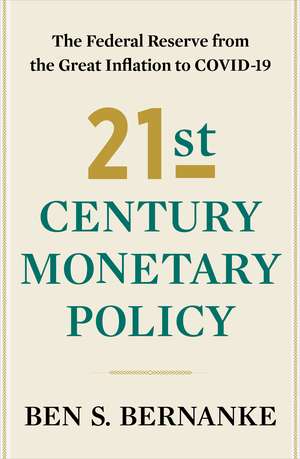23 November 2022
21st Century Monetary Policy
Ben Bernanke
2022, WW Norton, 512 pages,
ISBN 9781324020462
Reviewer: Lavan Mahadeva

Trust in macroeconomic policymakers has been deflated by many years of anaemic growth in the West and then punctured by successive stabs of financial crises, disease, war and now inflation. The mood has even turned against the independent central bank. In a populist era, where social media chatter can determine policy, Bill Bernanke’s book on 21st Century Monetary Policy is timely.
The book is split in two. The first part is an historical review of US Federal Reserve experience and the second a review of central bank’s tools and objectives. I liked this organisation: as I explain later, I really found the second part illuminating but to appreciate it, I needed to understand the context and be retaken through the experience.
Bernanke begins with the experiences of William McChesney Martin Jr. and Arthur Burns and recognises their failure in terms of inflation. Volker was given a remit to bring down inflation, but the book brings out the determination with which he pursued the task over a much longer time-span than I had believed. Bernanke’s account of the Greenspan era describes a consolidation of that success but also captures a technocratic optimism in engineering smooth landings. Compared to now, Volker and Greenspan seemed to have acted with more discretion with Greenspan proactively managing political relationships as well as economic levers. Bernanke’s own experience as Fed president was forged by the Great Financial Crisis and its aftermath. Readers will benefit from his explanation of the development of new tools and interventions such as liquidity swaps with other central banks, Quantitative Easing and Forward Guidance. The six years of Yellen and the current Powell era follow, with the inimical influence of Trump a key theme. The book ends in 2021, including an account of the Covid response and the CARES act.
The second half of the book is brilliant. With clarity and objectivity, Bernanke answers the questions that you might be asked over a dinner table: What is Quantitative Easing and has it worked? What is Forward Guidance? And does that work? What are the implications of a falling neutral interest rates? What are the side effects of Quantitative Easing? Does it create inequality? How should monetary and fiscal policy work together in a crisis? What is helicopter money and how useful is it? What is the best way of promoting financial stability?
Others might find the book (ending in late-2021) complacent about the powers of central bankers, but I do not think it is meant to be reassuring. Bernanke certainly emphasises that the monetary policy toolkit has expanded, especially in terms of what can work in a low inflation environment. Yet he is aware that large economic challenges of the scale described in the start of the book have re-emerged and that sometimes the best that can be done is to lower the public’s expectations of the extent of the possible macroeconomic rescue.
What I felt was too scattered or underemphasised was the re-assertion that an independent central bank can only operate when the rest of the set-up promotes resilience. At various points in the account, Bernanke explains how important in the operation of monetary policy was it that fiscal policy was not dominant; that (post-GFC) US banks were capitalised; that stock market crashes did not expose leverage; and that wages were not set on the expectations of compensating for inflation. 21st Century monetary policy, as described in the book, will be impossible when debt (speaking broadly) is unsustainable, or when the labour market cannot adjust to eliminate unemployment, which now constitute threats.
